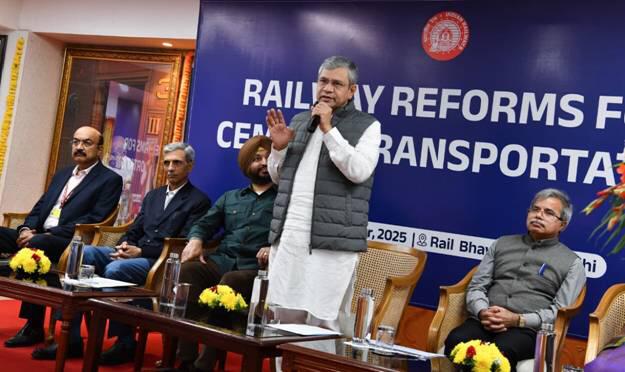Dhurandhar: Real-Life Inspirations Behind Ranveer Singh and Co. in the Film
Indian Railways Introduces New Policy to Reduce Cement Freight Costs and Support Affordable Housing
New Delhi, Nov 19
Indian Railways has announced a major new policy that aims to make the transport of bulk cement simpler, cheaper and more efficient. The move is expected to help reduce cement prices across the country, especially benefiting families building homes. Railway Minister Ashwini Vaishnaw introduced the new framework at Rail Bhawan in the capital, calling it a big step forward for both logistics and affordable housing.
One of the biggest changes in the policy is the removal of weight and distance slabs that previously determined cement freight charges. Instead, freight will now be calculated at a flat rate of ₹0.90 per tonne per kilometre, based on the train’s actual Gross Tonne Kilometre (GTKM). This simplified model is expected to lower costs for cement manufacturers and ultimately consumers. According to the minister, cheaper cement will directly help poor and middle-class families who depend on affordable building materials.
The policy also encourages the use of tank containers for cleaner and more efficient transport. These containers are built in India and follow standard dimensions. With a payload of 26 tonnes, they can be loaded or unloaded within half an hour, saving significant time. Their design allows them to move smoothly between trains and road trailers, creating a complete, end-to-end logistics system from factory to final destination.
During the announcement, Vaishnaw spoke about India’s rapid progress in freight handling. He said the country has now become the world’s second-largest freight carrier, leaving the United States behind. He also highlighted the fast expansion of rail lines—from only 4 km per day ten years ago to 12–14 km per day now. The Indian Railways network is also almost fully electrified, making it cleaner and more efficient. At the same time, more than 1,300 Amrit Stations are being developed to improve accessibility and services.
A key part of the new policy is the development of dedicated cement terminals across India. These terminals will include rail connections, silos for storage, hoppers, bagging plants, and other modern equipment. By building these facilities, railways hope to cut expenditure on logistics, reduce the need for road transport, and speed up the turnaround of cement rakes. This setup will also help reduce carbon emissions and improve the overall flow of cement from producers to users.
The reforms are expected to greatly improve large-scale cement movement throughout the country. With fewer packaging needs, quicker loading, reduced material wastage, and lower transport costs, the supply chain will become more reliable and efficient. Industry experts believe this new policy will give a major boost to housing and infrastructure development, ensuring that cement reaches construction sites faster and at a more affordable price.
The Indian Railways’ new policy marks a step toward a cleaner, faster, and more cost-effective way of moving one of the country’s most essential building materials.
Indian Railways Introduces New Policy to Reduce Cement Freight Costs and Support Affordable Housing
Indian Railways has launched a new policy aimed at making cement transport simpler and cheaper across the country. The updated system removes earlier distance and weight slabs and introduces a flat freight rate of ₹0.90 per tonne per kilometre. This change is expected to lower cement prices and make home construction more affordable for many families. Railway Minister Ashwini Vaishnaw described the initiative as a major step that will support both the cement industry and people building houses.
The policy also pushes for the use of tank containers that can carry 26 tonnes and be loaded or unloaded within half an hour. These containers can easily shift between trains and trailers, helping cement move smoothly from factories to cities and towns. Indian Railways will also support the creation of new cement terminals equipped with silos, hoppers and modern storage systems. This is expected to reduce delays, cut transport costs, and limit material wastage. Officials say the move will make cement logistics cleaner, faster and more efficient, helping boost affordable housing and infrastructure development across India.














Add Comment